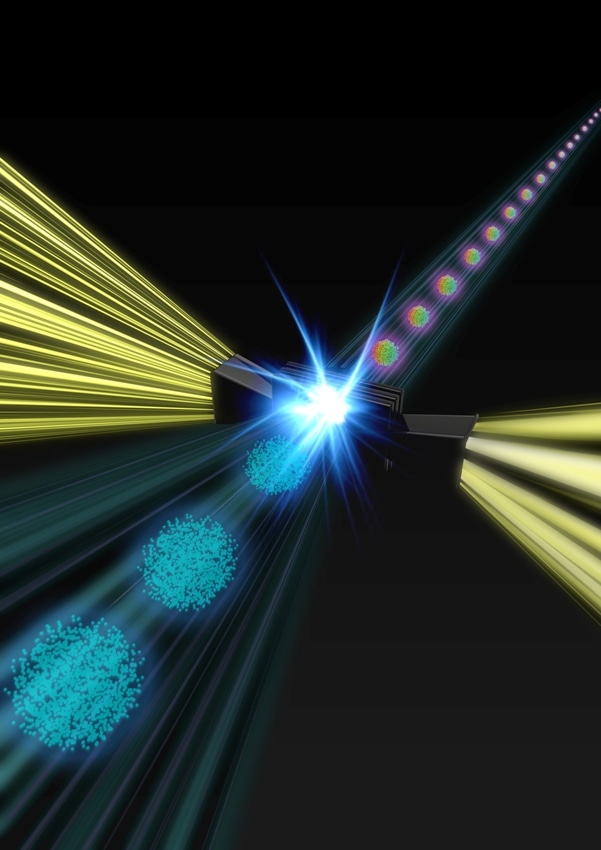By Matt Pullen, B.Sc.Apr 4 2018
A miniature particle accelerator for electrons with the ability to carry out four different functions at the push of a button has been developed by researchers from DESY. Driven by a Terahertz radiation source, the experimental device has the potential to accelerate, compress, focus, and analyze electron bunches in a beam.
The active structures of the device measure only a few millimeters across. The developers at the Center for Free-Electron Laser Science (CFEL) have described their “Segmented Terahertz Electron Accelerator and Manipulator” (STEAM) in the Nature Photonics journal. In the electromagnetic spectrum, the Terahertz radiation is located between microwaves and the infrared.
 The mini accelerator STEAM (center) is driven by Terahertz radiation (yellow, coming from both sides). It can accelerator, compress, focus, and analyze the incident electron bunches (blue). (Image credit: DESY, Lucid Berlin)
The mini accelerator STEAM (center) is driven by Terahertz radiation (yellow, coming from both sides). It can accelerator, compress, focus, and analyze the incident electron bunches (blue). (Image credit: DESY, Lucid Berlin)
One of the primary aspects of the device is its perfect timing with the electron beam. The researchers accomplish this by using the same laser pulse to produce an electron bunch as well as to drive the device.
To do this, we take an infrared laser pulse and split it up. Both parts are fed into nonlinear crystals that change the laser wavelength: For the generation of an electron bunch the wavelength is shifted into the ultraviolet and directed onto a photocathode where it releases a bunch of electrons. For STEAM the wavelength is shifted into the Terahertz regime. The relative timing of the two parts of the original laser pulse only depends on the length of the path they take and can be controlled very precisely.
Dongfang Zhang, First Author
In this manner, the researchers can control an electron bunch, with ultra-high precision, to hit the desired part of the Terahertz wave when it enters the device. STEAM carries out its different functions based on the arrival time of the electron bunch.
“For instance, a bunch that hits the negative part of the Terahertz electric field is accelerated,” explained Zhang. “Other parts of the wave lead to focusing or defocusing of the bunch or to a compression by a factor of ten or so.”
Compression corresponds to shrinking of the electron bunch in the direction of flight, whereas focusing corresponds to shrinking of the bunch in a direction perpendicular to the direction of flight.
Moreover, STEAM enables analyzing the structure of the electron bunch along its path of flight. In this method, known as streaking, the incoming electron bunch is deflected sideways such that it gets smeared out in a direction perpendicular to the direction of flight. When a detector is hit by this smeared out bunch, a profile of the bunch is produced along its path of flight. Streaking is frequently used to analyze the structures of the bunch in particle accelerators. “STEAM is a kind of Swiss army knife for electron beams,” stated Zhang. Several units of the device can be combined to perform multiple functions such as focusing and compression.
The use of Terahertz radiation also ensures the size of the STEAM device to be compact. “Terahertz radiation typically has a hundred times shorter wavelengths than the radio frequency radiation used in today’s big particle accelerators. Therefore, all the structures in the device can shrink accordingly,” explained Kärtner, professor at Universität Hamburg and lead scientist at DESY.
Since STEAM measures only about 2 cm on the largest side, it can be easily fit into a matchbox. “And that’s just the size of the housing. The active structures are on a millimeter scale,” added Zhang.
The technology is only at its experimental stage. The developers consider STEAM to be the initial step on the path toward a future generation of compact, Terahertz-driven particle accelerators. These could allow innovative applications and complement prevalent accelerators. Moreover, the pocket manipulator can even be utilized at present: accelerator groups across the globe have already been looking to use it for electron bunch characterization, as Kärtner indicated: “STEAM can be used for future table-top accelerators, but its various functions are also interesting for existing machines.”